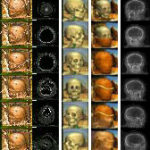[First posted in AWOL 29 November 2014, updated (new URLs) 18 November 2025]
The Virtual Mummy: Unwrapping a Mummy by Mouse Click
The computer has entered our everyday life and did not stop before the field of mummy research. It helps researchers not only in the non-destructive examination of mummies, but even allows the creation of a “virtual mummy”, which visitors of the exhibition The Secret of the Mummies – Eternal Life at the Nile, but also you (with limited functionality) can unwrap on the screen. The object is a 2300-year-old mummy of a female, aged about 30 years.
How the mummy was virtually reconstructed.
Here you can see inside the mummy’s head.
Here you can unwrap the mummy’s head on screen.












 Stumble It!
Stumble It!

No comments:
Post a Comment